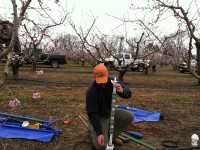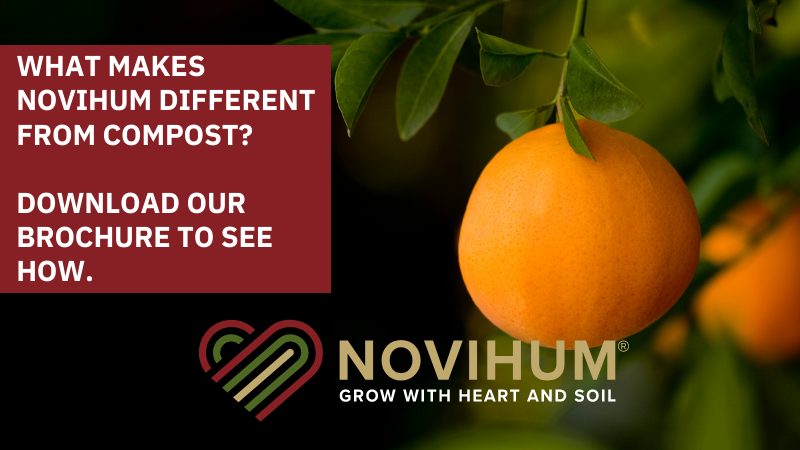Improved Irrigation Scheduling

Like several others across the country, peach growers in the Southeast are faced with increased pressure to use water more efficiently. Pending legislation in the southeastern U.S., for example, could dictate how much surface water can be used for agricultural production.
Thanks to a grant from the South Carolina Department of Agriculture that is matched by USDA specialty crop block grant funding, researchers at Clemson University are working to make this process easier for growers. “We’re looking for a system where we can modernize and automate our irrigation so the tree is telling us when it needs water,” says Greg Henderson, an Extension agent at Clemson University. Henderson’s son Will, a precision agriculture specialist with Clemson’s Edisto Research and Education Center, actually wrote the grant for this research.
“We need a better mechanism to report how much surface water we are using, so we can show we actually have a minimal impact on this valuable resource,” says Henderson.
Henderson’s goal was to study peach orchards with the same soil type, but with variable soil texture levels. Using a Veris 3100 Soil EC mapping system, they developed a soil map on a selected test block at J.W. Yonce & Sons farm in South Carolina. As expected, the map indicated varying soil textures within the block, which meant that moisture movement should differ in each of the different soil zones.
The next step was to actually measure soil moisture and movement. To do this, Henderson and his team partnered with Earthtec Solutions, a New Jersey-based data collection and analysis company that specializes in water and nutrient movement in agricultural crop management systems, on the use of soil moisture sensors that emit electronic pulses to determine moisture levels. “We know that the primary area for root activity is in the top 12 to 16 inches, but will the tree use water from a deeper depth?”
Moisture measurements were taken anywhere from a 10-centimeter depth down to 100 centimeters. All data collected from the sensors was uploaded via cell phone to Earthtec’s laboratory. In addition to soil moisture, the sensors can track temperature, wind speed, rainfall, and humidity. “We can look at transpiration and see how much moisture we are losing,” says Henderson. “This tells us how much is available to the tree.”
Maximizing Moisture
Studies indicated that down to 6 inches, there is a gradual decline in soil moisture. At 12 inches, the tree is feeding from an area where it’s finding moisture and is more adaptive to taking it up. Down to 70 centimeters, moisture is simply migrating from one zone to the other.
At 8 inches, the tree is pulling moisture from the upper soil level and moving it down, indicating that in periods of dry weather, moisture moves rapidly from one soil profile to the next. However, the most revealing data came when the grower initiated irrigation. When soil moisture was pushed to full capacity, water was pushed down past the point where the tree would take it up. “Because of this, we can time our irrigation for shorter intervals,” says Henderson. “We only need to irrigate down to where the moisture is being utilized by the tree.” It may be necessary to irrigate more frequently, but at the benefit of shorter durations.
Thanks to a renewal in grant funding for another year, Henderson and his team are already planning their next steps. Two of their upcoming goals are to measure soluble salts in the soil to track nutrient movement, and to evaluate standard irrigation during the crop’s final swell, versus completely automatic irrigation, on resulting fruit yield and quality. “The tree will indicate to us when we need to add water, and the soil will tell us when we need to cut the water off,” says Henderson.
Long-Term Benefits
Henderson says this research has the potential to offer several benefits to growers in his area, including:
• Reduced reliance on labor, as irrigation will become more automated.
• Improved fruit quality. Henderson says the problem with over-irrigating is that you might push necessary plant nutrients past the zone where the tree would pick them up.
• Meeting the needs of expanded crop acreage with a limited water supply.
Earthtec Solutions’ David Lankford gave a talk on this topic at the Southeast Regional Fruit and Vegetable Conference in January, and Henderson says growers were highly intrigued. “One of our growers said it was the most eye-opening piece of data he’d ever seen,” says Henderson. “He is initiating the installation of these sensors in a good portion of his peach production.”
Unexpected Benefit
This past winter was unusually warm in the South, which put peach trees at risk of not getting enough required chill hours. As it turns out, however, the Earthtec soil moisture sensors were able to record chill hours and chill units. “We were able to look at bud break and management of our high-chill varieties, which we had not been able to do in the past,” says Greg Henderson. “This gives us a comparison we can look at for how to manage crops that do not meet their minimum chill hours, and what effects we might see from this. This was not associated with our grant, but we’ve been able to piggyback it, and it’s been really well received by growers.”









